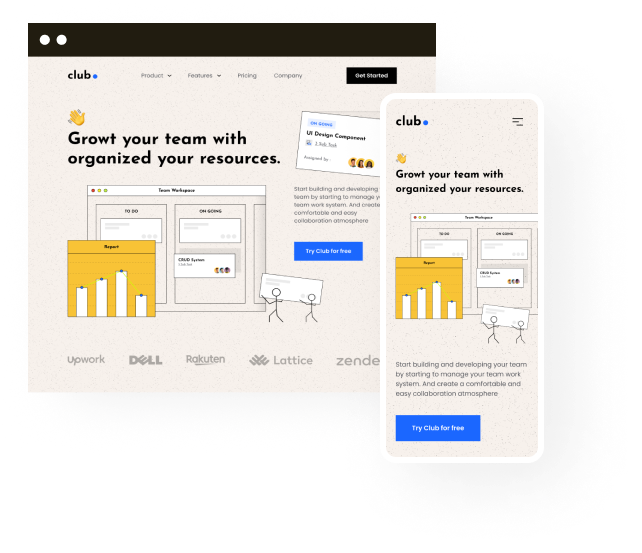
In today’s hyper-connected world, having a digital presence is no longer a luxury for businesses – it’s a necessity. Your website acts as your virtual storefront, a 24/7 salesperson that tirelessly informs, engages, and converts potential customers into loyal patrons. But for those unfamiliar with the digital landscape, the question remains: Why exactly is a website so crucial for business success?
This comprehensive guide dives deep into the importance of websites in the modern era. We’ll explore:
- What a website is and its core functionalities.
- Why websites are essential for businesses of all sizes.
- The different types of websites to suit your specific needs.
- The process of website development, from concept to launch.
- The advantages and disadvantages of having a website.
- Why SimpooCodes is the perfect partner for your website development journey.
Understanding Websites: The Foundation of Your Digital Presence
A website is essentially a collection of web pages accessible through the internet. These web pages are hosted on a server and can contain a variety of content, including text, images, videos, audio, and interactive elements. Your website serves as your digital address, allowing potential customers to find you online and learn more about your business offerings.
Think of your website as your online headquarters. It’s where you showcase your brand, communicate your value proposition, and provide a platform for customer interaction. Here are some of the key functionalities a website offers:
- Information Dissemination: Clearly communicate information about your business, products, and services.
- Lead Generation: Capture leads through contact forms, email signups, and calls to action.
- Brand Building: Establish a strong brand identity and differentiate yourself from competitors.
- Customer Engagement: Provide a platform for interaction, such as blog comments, social media integration, and online support.
- E-commerce: Facilitate online sales and transactions (if applicable).
- Marketing & Advertising: Leverage your website for SEO, content marketing, and paid advertising campaigns.
Why Your Business Needs a Website in Today’s Digital Landscape
The internet has fundamentally transformed how people discover and engage with businesses. Here’s why having a website is critical for success in the digital age:
- Increased Visibility: A website makes your business discoverable by a global audience 24/7. Potential customers can find you through search engines, social media referrals, and online directories.
- Credibility and Trust: A professional website instills confidence in potential customers. It demonstrates your legitimacy and commitment to serving your audience.
- Competitive Advantage: In today’s digital marketplace, having a website is an expectation. Without one, you risk losing ground to competitors who leverage the power of the internet.
- 24/7 Accessibility: Your website acts as a tireless salesperson, providing information and answering customer queries around the clock.
- Improved Customer Engagement: Websites facilitate a two-way communication channel. You can share valuable content, address customer concerns, and build stronger relationships.
- Cost-Effective Marketing: Compared to traditional marketing methods, websites offer a cost-effective way to reach a broad audience. You can leverage SEO, content marketing, and social media integration to attract organic traffic.
- Data & Analytics: Modern websites provide valuable data and analytics about your target audience. This data allows you to tailor your offerings, personalize user experiences, and optimize your marketing efforts for better results.
The Diverse Landscape of Websites: Choosing the Right Fit for Your Business
The world of websites is vast, offering a variety of options to cater to different business needs. Here’s a breakdown of some common website types:
- Brochure Websites: These static websites are ideal for showcasing your business information, products, and services. They are simple to set up and maintain but offer limited interactivity.
- E-commerce Websites: Designed for online sales, these websites allow customers to browse your product catalog, add items to a shopping cart, and complete secure transactions.
- Lead Generation Websites: Focused on capturing leads, these websites typically offer valuable content, white papers, or downloadable resources in exchange for user contact information.
- Portfolio Websites: Perfect for creative professionals like designers, photographers, and artists, portfolio websites showcase their work and expertise.
- Blog Websites: These websites regularly publish new content, establish authority in your industry, and attract organic traffic through search engine optimization (SEO).
- Membership Websites: Offering exclusive content or services, membership websites require users to subscribe or pay a fee for access.
Building Your Digital Home: The Website Development Process
Developing a website can seem daunting at first, but the process can be broken down into manageable steps:
1. Planning & Strategy
- Define Your Objectives: Begin by establishing the primary goals for your website. What do you aim to achieve? Do you want to increase online sales, generate more leads, or simply provide information about your brand?
- Identify Your Target Audience: Who are you trying to reach with your website? Understanding your ideal customer is key to tailoring your messaging and design accordingly.
- Content Planning: Outline the type of content you want to feature on your website, including text, images, videos, and blog posts. Consider keyword research for SEO purposes.
- Sitemap Creation: A sitemap is a hierarchical outline of your website’s pages and content. It helps both search engines and users navigate your site.
2. Design
- Wireframes: Wireframes are skeletal blueprints of your website’s layout and user interface. They focus on functionality and the arrangement of elements.
- Visual Design: This stage involves creating a visually appealing aesthetic that aligns with your brand. The design encompasses color schemes, fonts, imagery, and overall style.
- User Experience (UX): UX design puts the user at the forefront, ensuring your website is intuitive, easy to navigate, and provides a seamless experience.
- Responsiveness: Your website must perform optimally on different devices, including desktops, laptops, tablets, and smartphones. Responsive design is essential.
3. Development
- Platform and Technology: Choose a suitable content management system (CMS) like WordPress, Wix, or Shopify, or opt for custom development if advanced functionality is required.
- Front-End Development: This involves coding the design and user interface using HTML, CSS, and JavaScript to bring your website to life.
- Back-End Development: For websites with complex features, back-end development using languages like PHP, Python, or Ruby builds the underlying logic and functionality. This includes database integration, e-commerce capabilities, and user management systems.
4. Content Creation
- Copywriting: Develop persuasive and engaging text content for your website pages. Ensure clarity, readability, and incorporate relevant keywords for SEO.
- Multimedia: Create or source high-quality images, videos, and other visual assets for your website.
- Content Optimization: Strategically format your content to rank higher in search engine results.
5. Testing & Launch
- Functionality Testing: Ensure the website works flawlessly across different browsers and devices. Meticulously test all forms, links, and interactive elements.
- Cross-Browser Compatibility: Verify that your website displays correctly in all major web browsers, like Chrome, Safari, Firefox, etc.
- Performance & Speed Optimization: Website speed is crucial for both user experience and search engine rankings. Implement necessary optimizations.
- Launch: Once your website is tested and ready, it’s time for the exciting launch!
6. Maintenance
- Regular Updates: Keep your website’s content fresh and updated. This improves user engagement and boosts search engine visibility.
- Security Monitoring: Protect your website against potential cyber-attacks and security vulnerabilities with regular checks and updates.
- Backups: Create regular backups of your website’s data and files to ensure easy recovery in case of any issues.
Pros and Cons of Having a Website
Pros
- Increased visibility and reach
- Builds credibility and trust
- Improves customer accessibility and convenience
- Provides a platform for marketing and sales
- Facilitates data collection and analytics
- Allows for business growth and scalability
Cons
- Requires investment in design, development, and maintenance.
- Demands ongoing attention to ensure content is updated and security is prioritized.
- Can be competitive in saturated markets depending on your industry.
Why Choose SimpooCodes for Your Website Development Projects
At SimpooCodes, we don’t just build websites; we create powerful digital experiences that drive results for your business. Here’s why we’re the ideal partner for your web development journey: Checkout SimpooCodes services here
- Client-Centric Approach: We listen attentively to your unique needs and tailor solutions specifically for your business goals.
- Technical Expertise: Our seasoned developers bring a wealth of experience across various technologies and platforms to deliver exceptional websites.
- Innovative Design: We blend functionality and aesthetics to create websites that are both beautiful and easy to use.
- Transparent Communication: We maintain open communication channels throughout the project, ensuring you’re always updated and involved.
- Ongoing Support: We are here to support you even after your website launches.
Let’s Build Your Digital Presence Together!
Contact SimpooCodes today to schedule a consultation and unleash the power of a world-class website.


